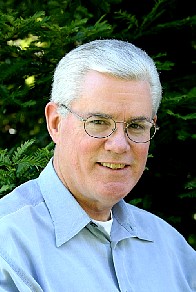Ramiro Reyna works in the DIRC tunnel inside the BaBar detector next to the spot where crews removed a damaged quadrapole magnet. (Photo courtesy Diana Rogers.)
Planned Downtime at B-factory Extended to Fix Magnet
by Heather Rock Woods
The planned one-week shutdown of PEP-II and BaBar has been unexpectedly extended a week to repair and reinstall a damaged magnet.
The Accelerator Systems Division had planned the downtime to take care of a vacuum leak near the interaction region where particles collide. To prepare for the work, everything near the interaction region was powered off. However, one of the quadrupole magnets did not shut down properly. When the cooling water to the magnets was turned off on May 1, that magnet overheated, charring the coils inside. Crews turned the cooling water back on, but the magnet was already damaged, and the heat caused water to leak into the BaBar detector. All daily system checks so far show the detector is in good working order.
Read more...
|
 Stan the Man:
He's all Business
by Alison Drain

SLAC's Director of Business Services has something to celebrate: his one month anniversary at the lab. The former President and CEO of GNB Corporation, which specialized in making high-vacuum valves, has worked in several manufacturing and engineering businesses over his career.
"I acquired a tremendous education by moving from business to business," he said.
"But I wanted to be part of something for a greater good. That's why I came to SLAC."
This isn't Cohelan's first time here, either. He has fond memories of working in the coil shop in the 1970s, helping to assemble the first SPEAR ring.
"I never forget being a small part of SPEAR, knowing that Nobel Prizes came out of that research," he said. "I never forgot that, and I never forgot SLAC."
Now, he's feeling at home among a new generation of SLAC-folk. "It's a really interesting culture here," he said. "The people are extraordinary." But Cohelan recognizes a challenge in his new job: meeting the needs of lots of different kinds of internal and external customer groups.
"It's a worthy challenge," he said. "I'm really excited about the science that's done here, and that I could play a small part in supporting it."
A warm welcome to Stan!
|
symmetry Magazine:
Masters of Improv
by Alison Drain
World-class detective Angus MacGyver of the hit 1980s television show MacGyver could jury-rig almost anything with duct tape and a pocket knife. High-energy physics labs demand as much and more from technicians and engineers, relying on their creativity and intelligence to navigate technical quagmires. And when a problem demands it, they deliver—engineering tiny cameras mounted on bocce balls that snake through 10,000 feet of steel piping; rigging a 13-ton cement block to bash deformed brass into shape; or aiming a high-powered laser around corners to unblock water lines. Unlike MacGyver's fixes—such as the fuse he repaired with a chewing-gum wrapper—some of these devices last.
Leon Lederman, the Nobel Prize-winning former director of Fermilab, is a legendary lab MacGyver. He used a pocket knife, tape, and items on anyone's grocery list to confirm that interactions involving the weak force do not show perfect mirror symmetry, or parity, as scientists had long assumed. Just as a watch hand always sweeps clockwise, nuclei of atoms eject electrons in a preferred direction as they decay, rather than spraying them randomly. The technical term for this is "parity violation.
Intrigued by the experiments of Madame Chien-Shiung Wu, Lederman called his friend, Richard Garwin, to propose an experiment that would detect parity violation in the decay of the pi meson particle. That evening in January 1957, Lederman and Garwin raced to Columbia's Nevis laboratory and immediately began rearranging a graduate student's experiment into one they could use. "It was 6 p.m. on a Friday, and without explanation, we took the student's experiment apart," Lederman later recalled in an interview. "He started crying, as he should have."
Read more...
|
Lab Announcements
Community Bulletin Board
|





 <%
Response.AddHeader "Last-modified", getArticleDate()
'Response.AddHeader "Last-modified","Mon, 01 Sep 1997 01:03:33 GMT"
'Monday, December 06, 2010
%>
<%
Response.AddHeader "Last-modified", getArticleDate()
'Response.AddHeader "Last-modified","Mon, 01 Sep 1997 01:03:33 GMT"
'Monday, December 06, 2010
%>